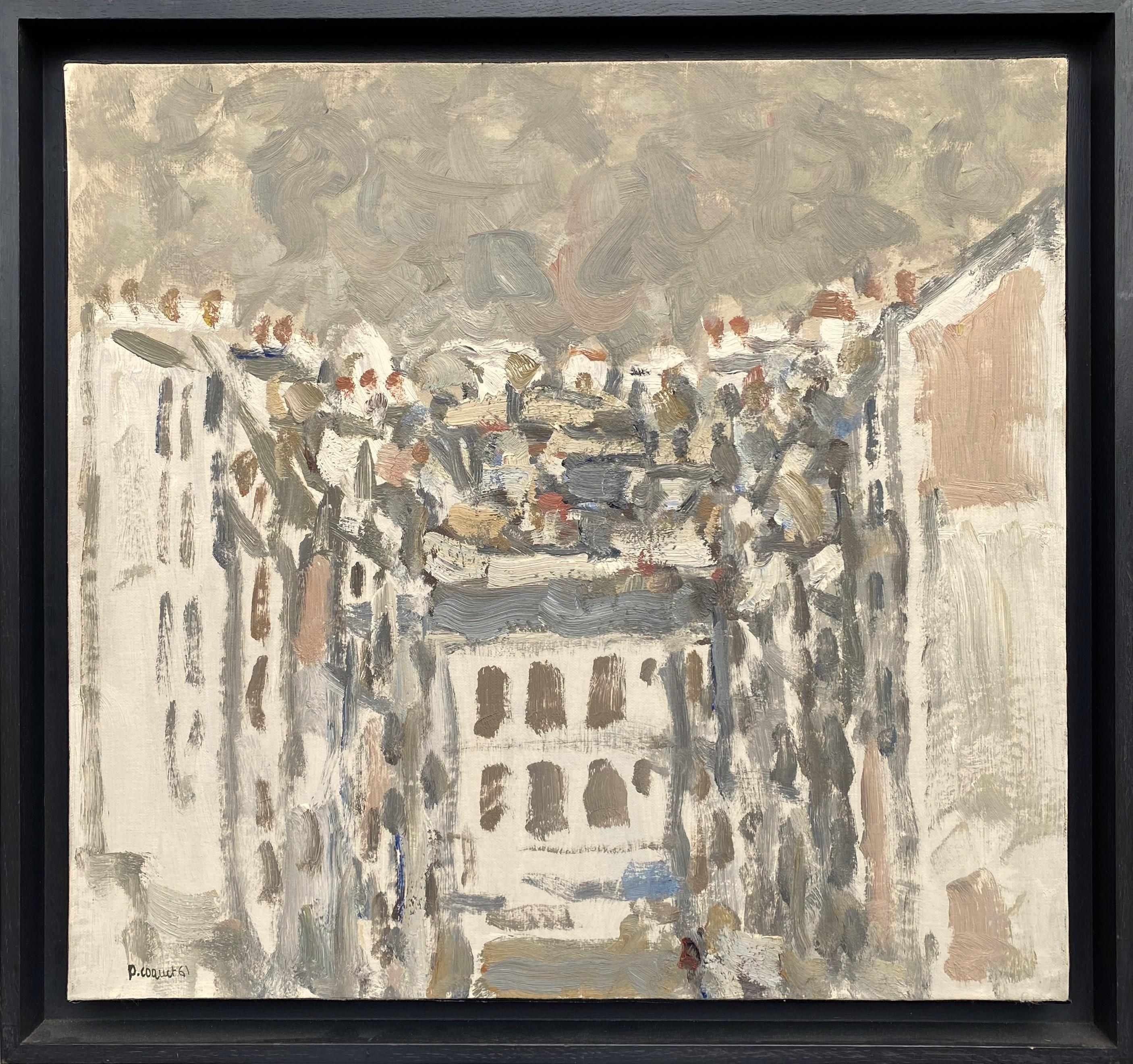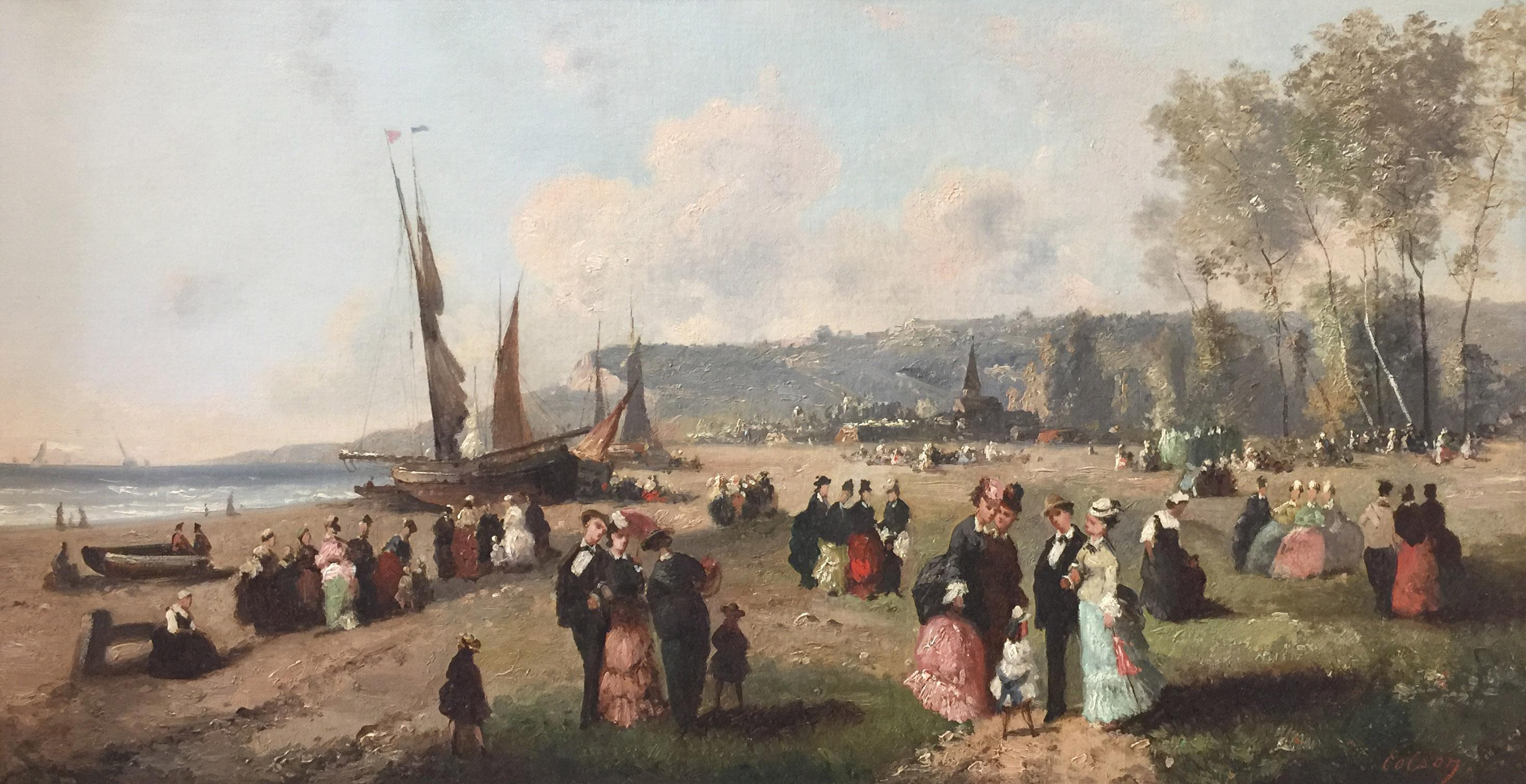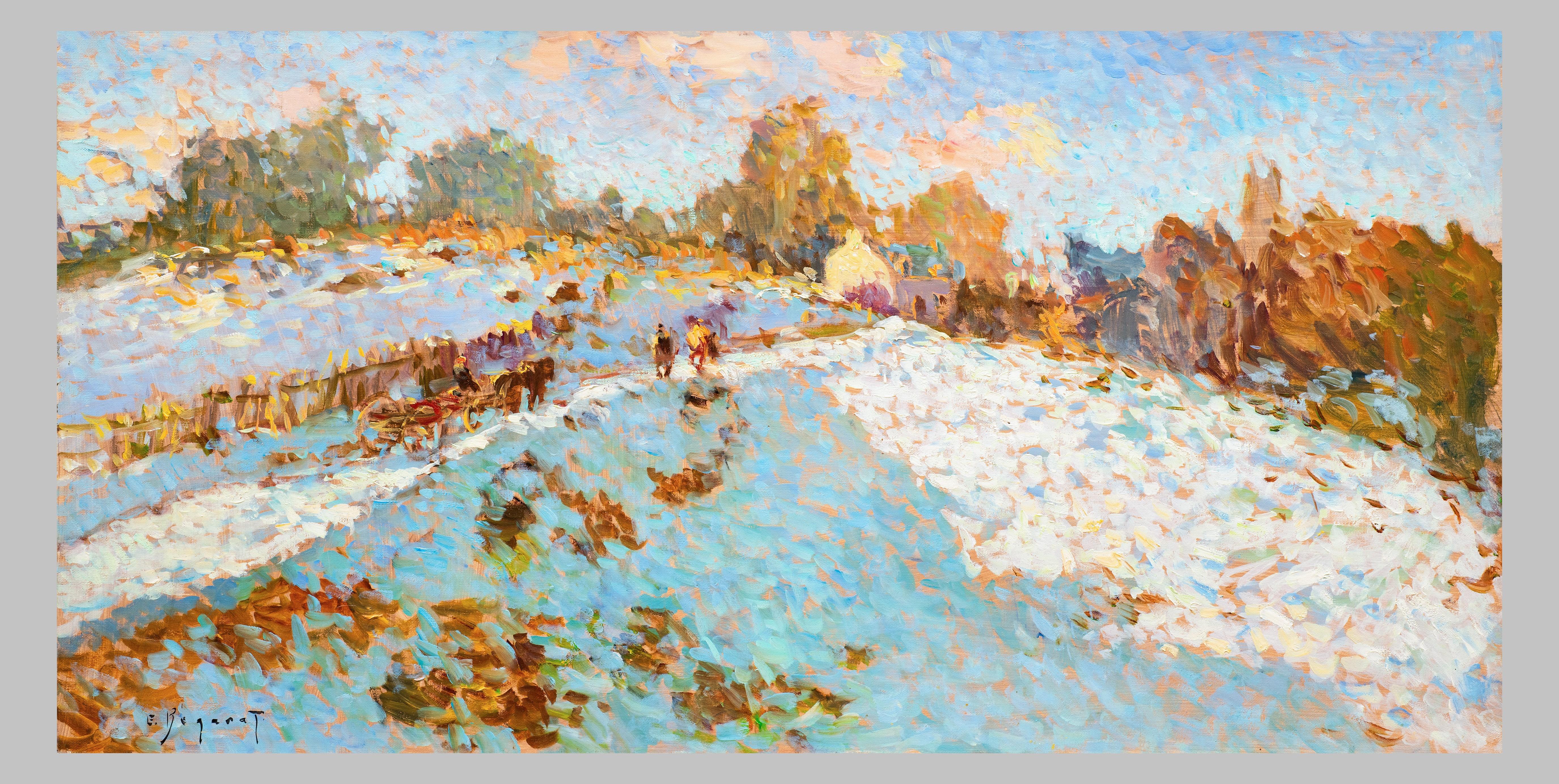Items Similar to Charles Merme (1818-1869) The blessing of Coureau de Groix in Larmor Brittany
Want more images or videos?
Request additional images or videos from the seller
1 of 8
Charles MerméCharles Merme (1818-1869) The blessing of Coureau de Groix in Larmor Brittany1869
1869
About the Item
Charles MERMÉ
(Cherbourg 1818 - Lorient 1869)
The blessing of Coureau de Groix at Larmor
Oil on canvas
H. 60 cm; W. 100 cm
Signed and dated lower left, 1869
Exhibition: 1869, Salon de Paris, under number 1693, titled Le village de Laror (sic), the day of the blessing of couraux (sic) (Brittany)
Artillery captain in the Navy, Charles Merme travels the seas of the world on ships to carry him to distant lands. He will visit the Mediterranean, the Comoros, will remain stationed in Guadeloupe from 1863 to 1865, and fifteen years earlier he made a stopover of several years in Reunion. He will bring back many works of these lush landscapes which can be found today in several French museums. His attraction to the sea is logically found in the vast majority of his compositions. Amateur painter as a daily sailor, he nevertheless exhibited at the Salon from 1843, until the year of his death in 1869. It was also in this last year that Merme exhibited this large Breton canvas, but post-mortem. He actually died a month before the opening of the Salon of a foudroyant Anthrax (anthrax). Le Monde Illustré devotes an obituary to him which alludes to our painting: "he had just sent the jury two new paintings, which cannot fail to be noticed", and recalls his merits: "He excelled at rendering the horizons of the morning , and its skies had a brilliance and transparency that few painters have been able to render with so much skill and finesse ". Recognized by the Académie des Beaux-Arts, Merme benefits from lessons from Prosper Marilhat and Théodore Rousseau, he takes part in various regional exhibitions where he exhibits, as in Paris, works from his various trips. In 1859, Le Monde Illustré reproduced a work by Merme that he presented at the Salon that year, and made the following benevolent criticism: "... the transparency of its waters, the vigor and richness of its first plans , the lightness of its funds and the depth of its sky make of this simple and true study a precedent which engages the future of M. Merme. We will certainly find him at the first exhibition, more sure of himself, struggling with the most strong, and having acquired the difficult sympathy of the public. ". Charles Merme realizes here a grandiose canvas of a mythical moment that a small town in Morbihan brings to life every year on Saint John (June 23), near Lorient. On the beach of Port Maria, in Larmor, a procession advances towards the pier which embarks on various ships to reach a central point between the municipalities of Ploemeur, Larmor, Port-Louis and Gâvres, in the direction of the island of Groix more to the south. This area gives access to the port of Lorient and is called "Coureau de Groix". It is feared by sailors because of the strong force of the currents, particularly during high tides. It is these dangerous currents that the clergy of the five communes (including that of Groix) come to bless in the open sea, for the safety of sailors and the quality of their fishing. In 1843, Marteville and Varin described this blessing with a few omissions, but the tone was set: “This is where we make the most abundant sardine catch on all our coasts. It is also there that the blessing of fishing takes place every year, on Midsummer's Day. That day the population of Groix, clergy and banner in the lead, got into their boats and reached the middle of the coureau. For its part, the mainland population, part of the village of Armor with the clergy of Ploemeur, arrives by force of oars. The clergy meet in a single boat; the two parish crosses then bow towards each other and embrace. At this signal, the sailors 'songs burst out in unison and do not stop until the rector of Ploemeur gets up on one of the rowers' benches, and with a paternal gesture imposes silence on this noisy crowd. Prayers replace songs, holy water is launched at the four cardinal points, and the silence is such that one would hear this water fall into the sea. Each sailor prays in his heart and fervently implores the sky to give back abundant fishing which must give the existence to all his family. Finally the prayers cease, the banners bow again, the two clergy separate; the songs begin again and the boats return to the port where many libations come to end this day and take away its splendid and sublime character. »Our canvas perfectly depicts this departure from the mainland where the curious will stay on the rocks to get drunk on this visual and sound spectacle, which some will even watch with a telescope. Bourgeois as close as possible to the water, families of sailors or farmers behind.
Seven years earlier, the painter produced another version, reproduced in Le Monde Illustré, in 1862 (Fig. 1).
- Creator:Charles Mermé (1818 - 1869, French)
- Creation Year:1869
- Dimensions:Height: 23.63 in (60 cm)Width: 39.38 in (100 cm)
- Medium:
- Movement & Style:
- Period:
- Condition:Perfect condition. Cleaned.
- Gallery Location:BELEYMAS, FR
- Reference Number:1stDibs: LU1860210072572
About the Seller
No Reviews Yet
Vetted Seller
These experienced sellers undergo a comprehensive evaluation by our team of in-house experts.
Established in 2011
1stDibs seller since 2022
- ShippingRetrieving quote...Ships From: BELEYMAS, France
- Return PolicyThis item cannot be returned.
More From This SellerView All
- François-Edme Ricois (1795-1881) View of Châteaudun castle and city in FranceLocated in BELEYMAS, FRFrançois-Edme RICOIS (Courtalain, 1795 - Mareil-Marly, 1881) View of Châteaudun Oil on canvas H. 65 cm; W. 98 cm Signed and dated lower center 1860 François-Edme Ricois although bor...Category
1840s French School Figurative Paintings
MaterialsCanvas, Oil
- View taken in the Park of Saint-Cloud near ParisLocated in BELEYMAS, FRAlexandre-Hyacinthe DUNOUY (Paris, 1757 – Jouy en Josas, 1841) View taken in the park of Saint-Cloud Oil on paper mounted on canvas H. 31.5 cm; L. 24 cm Around 1820 Provenance: -Per...Category
1810s French School Figurative Paintings
MaterialsCanvas, Oil
- Maurice Lobre (1862 -1951) The snackBy Maurice LobreLocated in BELEYMAS, FRMaurice LOBRE (Bordeaux 1862 - Paris 1951) Le goûter Huile sur toile H. 87 cm ; L. 91,5 cm Format peint d’origine, H. 101 cm ; L. 96 cm, disposé sur un châssis plus petit par l’artiste lui-même. Signée et datée 1888 en bas à droite Provenance : Collection privée, Lyon Exposition : 1889, Salon des Artistes Français, n°1719 « Intérieur », (ou 1720 nommé également « Intérieur ») Œuvres en rapport : Le Cabinet de toilette de Jacques-Emile Blanche, (titre erroné) H. 80 cm ; L. 85 cm, HST, Museo Thyssen-Bornemisza, Madrid, pendant de notre toile. Maurice Lobre a-t-il connu Marcel Proust ? On ne peut encore l'affirmer, bien qu'il ait eu de nombreux amis en commun avec l'écrivain. Mais sa peinture intimiste pourrait illustrer certaines pages de Du côté de chez Swann. Trois citations dues à des proches de Proust, l'une de l'écrivain Léon Daudet, la seconde du peintre Jacques-Emile Blanche, la dernière du poète mondain Robert de Montesquiou, donnent un aperçu de ce que fut la renommée de Maurice Lobre en son temps : "Il en va autrement de Lobre, le Vermeer français, le peintre exquis des intérieurs et des palais de Versailles, des reflets sur les meubles rares, de la lumière prisonnière des miroirs, des laques et des cuivres polis. Lobre est joyeux comme un coup de vent, qui fait envoler les préjugés et les poncifs, éloquent, passionné, ivre de la couleur et des formes, charmant et conquérant de toutes les matières. Il se promène ici-bas ainsi que dans un musée en plein-air, s'amuse de tout, rejette et maudit le laid et le vil, accueille et bénit le beau et le bien…" Léon Daudet L'Entre-deux-guerres. Souvenirs des milieux littéraires, politiques, artistiques et médicaux de 1880 à 1905. "Voici le patient, appliqué, sage M. Lobre. Il est difficile de mettre plus d'honnêteté à peindre des intérieurs sans figures. Je préfère ses petits salons de Versailles à ses cathédrales… Nous lui devons des petits bijoux d'émotion et de large fini." Jacques-Emile Blanche "Il a recueilli sur des toiles le visage du vieux Versailles (…). Il a peuplé de visions impalpables des chambres " où il s'est passé quelque chose ", et il en a saturé l'atmosphère de particules historiques. Donner une telle impression avec certitude, avec vérité, c'est plus difficile que de faire évoluer des personnages costumés, dans ce qu'on appelle bêtement "une reconstitution historique"." Comte Robert de Montesquiou Maurice Lobre commence sa carrière au Salon de 1882 où il expose deux portraits, dont celui de son camarade de l'atelier Carolus-Duran, le peintre espagnol Ramon Casas...Category
1880s French School Figurative Paintings
MaterialsCanvas, Oil
- Roof of ParisLocated in BELEYMAS, FRHenri Ernest Clément DUPONT-CRESPIN (Notre Dame de Bondeville 1882 – Paris 1953) View of the rooftops of Paris Oil on canvas H. 65 cm; L. 92 cm Signed and dated lower right “3-1948” Exhibition: 60th exhibition of the Salon des Indépendants from April 22 to May 15, 1949 at the Musée des Beaux-Arts de la ville de Paris under number 893 Henri Dupont was born in Normandy near Rouen, and to stand out from his very, even too classic, name, he adopted that of his mother as a complement, which would become his unique artist name. He was a drawing teacher at the Épinal high school and also worked at the town museum, lending his eye to the identification of several old paintings. From 1928 and until the day before his death, Dupont-Crespin exhibited at the Salon des Indépendants. The vast majority of his works are landscapes, but there are also portraits of his colleagues, friends and relatives. In 1940 he published a collection of engravings...Category
1940s French School Figurative Paintings
MaterialsCanvas, Oil
- Landscape of Ile de FranceBy Jean-Victor BertinLocated in BELEYMAS, FRJean-Victor BERTIN and workshop (1767, Paris – 1842, Paris) Landscape of Ile de France Oil on canvas H. 38 cm; L. 46 cm Related work: painting of the same composition preserved at t...Category
Early 1800s French School Figurative Paintings
MaterialsCanvas, Oil
- Henri Pailler - Snow in Triel sur SeineBy Henri PaillerLocated in BELEYMAS, FRHenri PAILLER (Poitiers 1876 - Triel-sur-Seine 1954) Snow in Triel sur Seine Oil on canvas H. 54 cm; L. 73 cm Signed lower left Provenance: Private collection, Vienne A native of Poitiers in Vienne, Henri Pailler shows serious drawing skills. Noticed by Edmond Petitjean, the young man was sent to Paris to complete his training at the Beaux-Arts under the aegis of the great Léon Bonnat. First of all accustomed to a style and a very academic palette, the young painter quickly branched off from this classical art which he hardly liked. From the beginning of the century he moved towards Impressionism which he deployed within the Crozant school thanks to his meeting with Armand Guillaumin who took him to paint on the motif in 1901. Residing in Poitiers until the At the dawn of the great conflict of 1914, Pailler sent to the Salon many landscapes of the Creuse where the liveliness of colors was more and more felt. It is precisely following the meeting with Dufy and Marquet that a fawn side appears in his compositions, but after a few years he instinctively returns to his love for impressionism by keeping a generous amount of hues on his palette. On his return from the war, Henri Pailler joined Roubaix where he was appointed workshop professor at the School of Industrial Arts. On his retirement he will settle on the banks of the Seine in Triel-sur-Seine, of which he will realize many views with the talent and the colors so appreciated by this painter considered to be one of the greats of Crozant. Throughout his career, Pailler will travel through France and regularly in Périgord, from which he will bring back many works by Bourdeilles mainly but also Brantôme. From the 1920s, the painter will present views of Triel-sur-Seine in the Yvelines in various salons. This town, whose church with its distinctive silhouette will be the playground for Pailler's easel until his death. Our painting undoubtedly made in the 1920s is a striking winter image...Category
1920s French School Figurative Paintings
MaterialsCanvas, Oil
You May Also Like
- View of Paris, oil painting by Pierre CoquetLocated in Montfort l’Amaury, FRReference number F367 The painting is framed with a dark grey wood floated frame. 50 x 53 cm frame included (45 x 48 cm without frame) This work is painted with oil on a canvas. It i...Category
1960s French School Figurative Paintings
MaterialsCanvas, Oil
- Guillaume-François Colson - Sur la plage, french, beach, 19th century, paintingLocated in London, GBGuillaume-François Colson (1785-1860) Sur la plage oil on canvas 35 x 65 cm signed 'Colson' (lower right) Price: £18,000 GBP Provenance: MacConnal-Mason Fine Paintings Private coll...Category
19th Century French School Landscape Paintings
MaterialsCanvas, Oil
- Pointillist Painting "The Road Beneath the Snow" Eugène Bégarat (French, 1943)By Eugène BégaratLocated in SANTA FE, NMPointillist Painting "The Road Beneath the Snow (Le Chemin Sous la Neige)" Eugène Bégarat (French, 1943) Oil on canvas 15 3/4 x 31 1/2 inches Saturated with winter's light glinting...Category
20th Century French School Landscape Paintings
MaterialsOil, Canvas
- A Soldier Blowing the Trumpet by French Artist Charles Bouchez, Oil on CanvasLocated in Stockholm, SECharles Bouchez (1811-1882) French A Soldier Blowing the Trumpet oil on canvas signed and dated ch. Bouchez 1842 canvas dimensions 6.29 x 4.13 inches (16 x 10.5 cm) frame 10.23 x 7...Category
1840s French School Figurative Paintings
MaterialsCanvas, Oil
- In the Garden, French school impressionist, original oil on canvas, figurativeLocated in Nutfield, SurreyAn early 20th Century French School oil on canvas painting of a lady and her dog in a garden in summertime. This high-quality warm and vibrant, although unsigned, work is deftly pain...Category
Early 20th Century French School Figurative Paintings
MaterialsCanvas, Oil
- Boy in a landscape, large art deco period paintingLocated in Norwich, GBThis luminous landscape is perfectly capturing the light of early spring. A boy is climbing over wooden farm gates, with a backdrop of rolling hills. The painting has a gloriously fr...Category
1930s French School Landscape Paintings
MaterialsCanvas, Oil





